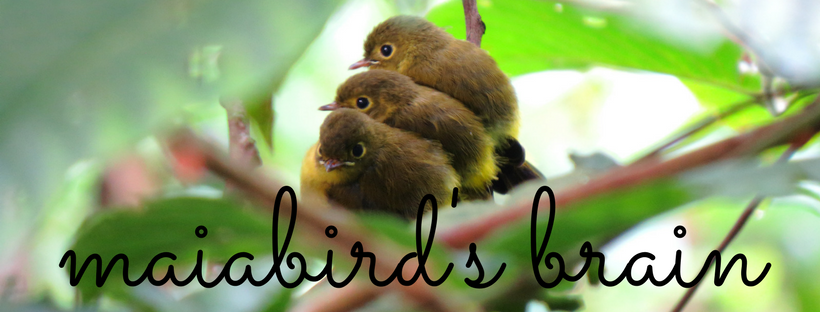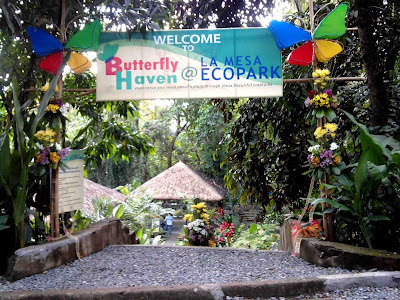I've only recently learned about owls regurgitating pellets. I've also only recently learned about the petroglyphs in Angono. So when WBCP friend Vincent reported seeing an owl in the area, it would be a double treat for me!
En Route
It took us an hour and thirty minutes to drive to the site from Quezon City, with a brief Jollibee stopover for take-out breakfast. We drove through Imelda Avenue (which reminded me of the road conditions in Candaba.) We pushed further on towards the Thunderbird Resort (just follow the signs), left an ID at the guardhouse and missed the cave entrance to the site. If you're coming from the Cainta route, watch out for the BACK of this sign:
 |
| If you're coming from the Antipolo route, you'll be greeted with the front of the sign. |
The guard at the next gate, told us we missed the entrance to the petroglyph site by a few meters. We made a u-turn and saw the tunnel opening. Coming from Cainta, it will be on your left.
We parked before this tunnel, spent a few minutes observing some Tawny Grassbirds just beside our car, and then went in. It was a short walk from this point to the mini-museum in the site. Unfortunately, it was closed the time we were there since they were setting up an exhibit. We registered, paid the P20.00 entrance fee and walked up to the view deck.
 |
| The view deck to see the petroglyphs. I love view decks!!! Perfect for dude birding! |
Pellets
When we saw our first owl at the start of the year, it was only then that I learned that owls, like some other birds, regurgitate the indigestible parts of the prey they eat. Since they don't have teeth to chew their food, owls tear apart their meal and swallow large chunks whole. In their gizzard, the bones, fur and feathers are separated from the softer, digestible parts. The harder materials are then formed into a pellet and is expelled before the owl eats another meal. Amazing right?!
I was so excited to see my first owl pellet but I honestly completely forgot about them when I saw the Philippine Eagle Owl atop a mango tree.
 |
| Philippine Eagle Owl Bubo philippensis |
I was so engrossed looking at this beautiful bird staring back down at me that I needed Jops to remind me about looking for some pellets! I took one last long look at the owl, then backtracked to scan the ground. At first I was strictly looking for rounded balls of hair and fur but didn't find any. Since I haven't seen any pellets before, I didn't really know what I was looking for. But then my eyes focused on a clump of bones! It was a semi-disintegrated pellet!
 |
| The first pellet I found wasn't round anymore, but I could see a skull, part of a mandible, some smaller bones and clumps of hair! My first owl pellet! |
I then started noticing lots of bones and clusters of hair around the spot where I was standing! This owl has been eating A LOT! We also found some feathers on the ground.
 |
| I collected some bones and a couple of feathers to examine closer. The small skull intrigued me since it had tiny molars(!), also on the accompanying mandible it came with in the same pellet. |
Petroglyphs
After getting my fill of the owl pellets, I took some time to study the petroglyphs. Petroglyphs are prehistoric carvings or line drawings on rocks. The 127 drawings on the rock face in front of me were discovered in the 1960's by National Artist Carlos "Botong" Francisco while camping in the area.
 |
| The rock face where the petroglyphs can be seen. |
According to the guide, Sir Roden, the petroglyphs were found to be dating back to the Neolithic Period which is around 3,000BC. Among the drawings, there are 51 distinct types which means that 51 different individuals contributed to the drawings at different times. These include human figures which are being associated with rituals (as evidenced by the bent arms and legs of the figures) and animal figures.
 |
| Can you make out the figures? |
Another Owl!
We spent the rest of the morning in the view deck, enjoying the mixed flock of birds that would come and go around us. Elegant Tits, Lowland White-Eyes, Black-naped Monarchs would fly noisily overhead while a White-throated Kingfisher would make some appearances too. Philippine Coucals would skulk around before gliding above us towards the golf course below. We heard lots of rails and even a pitta calling! Suddenly, Jops was saying "Hello there!" to something on the wall, as if speaking to a baby. I looked up and saw the head of another Philippine Eagle Owl, peering at us from a crevice on the wall!
 |
| "Hello there!" indeed! It was so cute and it looked so fluffy! |
It showed itself for a few minutes before moving deeper back into its "cave." We allowed ourselves to bird til noon. At exactly 12:00, we left the place happy with a full morning spent with the owls and petroglyphs plus 23 species in our bird list. =)




















